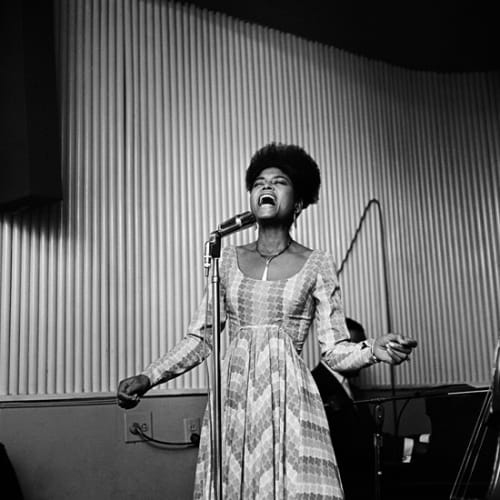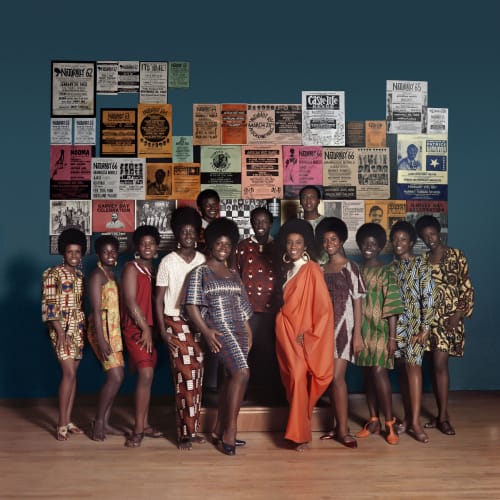LOS ANGELES - Black is beautiful.
It's a catalyzing phrase that radically instilled pride among African Americans and redefined beauty standards around the world. The iconic slogan is also the title of Kwame Brathwaite's first major museum exhibition at the Skirball Cultural Center in Los Angeles.
Black is Beautiful: The Photography of Kwame Brathwaite explores the origins of the phrase through the visual imagery he created to promote natural beauty and the cultural flashpoints he captured on film that sparked the Black is Beautiful movement of the 1960s and 1970s.
Brathwaite's work, which is rooted in jazz and photography, fuses the two mediums into a powerful tool used to shape and promote social change. Among the 40+ images on display, his work not only preserves seminal musical moments, but it also pushed the boundaries of beauty that would transform how we define Blackness for generations to come.
The musician Max Roach once said that "Jazz music is collective creativity," and within the Skirball's exhibition, that collaborative spirit is captured in Brathwaite's candid black and white photographs of jazz legends of the 1950s and 1960s. Music provided common ground for activists to collectively engage with creatives to promote Black empowerment and economic independence.
A follower of the Black nationalist ideology of Marcus Garvey, Kwame Brathwaite's love of jazz and his ardent support of Pan-Africanism inspired his foray into photography. The artist and his brother Elombe Brath, along with a group of young, like-minded jazz aficionados, formed a social club called the African Jazz-Art Society (AJAS). Members of the AJAS included artists, writers, and designers who collectively promoted small jazz shows in the Bronx featuring musicians who were culled from headlining acts that performed downtown. These smaller, more intimate sessions became wildly popular, and through their heavy promotion and networking, the AJAS cultivated strong relationships with musicians who Brathwaite began to photograph in the late 1950s. Among the many photos of jazz legends displayed in the exhibition, images of singer and actress Abbey Lincoln stand out, not only for her striking beauty but because of her hair.
In the 1950s, Lincoln was a cabaret singer whose cameo in a 1955 Jayne Mansfield film propelled her into the spotlight - in the film, Lincoln wore an iconic red dress originally worn by Marilyn Monroe in the movie Gentlemen Prefer Blondes. By the late '50s, Hollywood's desire to mold Lincoln into a sexy starlet was at odds with the singer's own desire to embrace her natural beauty. During a time when studios ascribed to Eurocentric aesthetics, Lincoln's choice to wear a short Afro ran counter to the straight-haired, fair-skinned, prototypical femme fatale. In Black is Beautiful, Brathwaite's photos of the singer capture Lincoln's pivot from acting to jazz and her embrace of her natural, coily hair. The singer eventually married drummer and collaborator Max Roach, and in a symbolic shedding of her former image, Lincoln burned the Marilyn Monroe dress in an incinerator, a gesture that's also a powerful indictment on the pervasiveness of narrow beauty standards.
Another series of images depart from Brathwaite's documentary style jazz photography and ventures into street photography, which captured the pivotal moments that shaped the Black is Beautiful movement. In the exhibition, a 1963 photograph of a storefront protest at Wigs Parisian in Harlem encapsulates two important tenets of the AJAS: economic independence and Black empowerment, which became synonymous with the slogans Think Black, Buy Black, and Black is Beautiful. In the black and white image, shot from a low angle behind a parking meter, women with close-cropped Afros wore sandwich signs that implored: "Natural … YES! Wigs … NO!", encouraging Black women to embrace their own natural hair instead of patronizing businesses that reinforce beauty standards that exclude their unique attributes.
For Black women, the political economy of hair has been fraught with internalized conflict over issues of acceptance and desirability, much like the external pressures Abbey Lincoln faced in Hollywood. In the 1960s, Black women asserted their power over these conflicting standards by upending them, choosing to embrace the simple, yet radical act of wearing natural hair. In Black is Beautiful, four large-scale color portraits feature Black women whose glorious crowns of natural hair and dark skin radiate from the gallery walls. These images don't simply challenge European standards of beauty, they also confront deep seeded issues of colorism within the Black community through affirming the beauty of darker hues and African features.
The subjects featured in Brathwaite's portraits were part of a modeling troupe sponsored by the AJAS called Grandassa. The Grandassa models wore natural hair and flaunted African diasporic designs and accessories they created themselves. Some of the most elaborate works were intricately beaded earrings and headpieces created by Carolee Prince, whose designs were worn by the singer Nina Simone.
The Grandassa Models became well known through a series of bi-annual fashion shows that debuted in 1962. The inaugural event title reads like a Grandassa mission statement: "Naturally '62: The Original African Coiffure and Fashion Extravaganza Designed to Restore Our Racial Pride and Standards." The show was Black is Beautiful set in motion. Naturally, shows celebrated African heritage through design while reinforcing economic independence and empowerment. Building on a growing demand for AJAS's photography and graphic design work, in 1961 the group acquired studio space and became the African Jazz-Art Society and Studios (AJASS). Through the Naturally fashion shows, photography, and design, the beauty of Blackness was on full display, capturing the attention of non-Black audiences as well.
Brathwaite's relationships within the jazz scene and the success of the fashion shows led to a unique collaboration between the photographer and Blue Note Records who featured Grandassa models in a series of album covers produced by the label in the '60s. Blue Note's decision to feature Black models with natural hair was a revolutionary departure from the iconic cover designs created by Francis Wolff and Reid Miles, who relied heavily on black and white photography, graphic design, and typography. Samples of the album covers photographed by Brathwaite are on display in the show, serving as an important touchstone in Black is Beautiful's entrance into mainstream culture.
The Aperture Foundation has published an accompanying monograph titled Kwame Brathwaite: Black is Beautiful which is scheduled for release in May 2019. The book continues the exploration into the historical influences and social dynamics that allowed Brathwaite's work and activism to thrive in the 1960s. Essays by professors Tanisha C. Ford and Deborah Willis add critical context to Brathwaite's images. Together, the exhibition and the monograph are important footnotes to a slogan that has become both a state of mind and a revolutionary movement.
Black is Beautiful: The Photography of Kwame Brathwaite is on view at the Skirball Cultural Center (2701 N Sepulveda Blvd, Los Angeles, CA 90049) through September 1. The exhibition was curated by Skirball managing curator Bethany Montagno; Aperture Foundation's Michael Famighetti; and Kwame Brathwaite's son, Kwame S. Brathwaite. The exhibition will travel to the Museum of the African Diaspora in San Francisco and Columbia Museum of Art in South Carolina in late 2019 and 2020.



